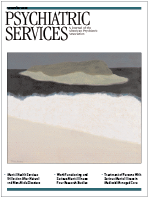Community Tenure of People With Serious Mental Illness in Assertive Community Treatment in Canada
Abstract
OBJECTIVE: This study followed consumers after admission to an assertive community treatment program to determine when the first hospital admission was more likely to occur, which variables predicted community tenure, and, more specifically, whether the availability of within-program hospital beds predicted community tenure. METHODS: Data were gathered from three assertive community treatment programs in southeastern Ontario—the psychosocial rehabilitation program, the community integration program, and the assertive community treatment team program. Only the psychosocial rehabilitation program provided within-program beds. Hospital records of consumers who entered a program between July 1, 1990, and December 1, 1999, were examined prospectively until January 1, 2000, in order to record time to the first admission. Survival analysis based on the life-tables method was used to estimate the probability of remaining out of the hospital at 90-day intervals. Factors associated with time to admission were identified by using the Cox proportional hazards model. RESULTS: A total of 333 consumers were followed: 117 consumers in the psychosocial rehabilitation program, 105 in the community integration program, and 111 in the assertive community treatment team program. Findings indicated that consumers were most likely to be admitted to a hospital in the nine months after entering an assertive community treatment program. A diagnosis of substance use disorder, higher past hospital use, and the availability of within-program beds were associated with an increased risk of admission. CONCLUSIONS: Studies have shown that hospitalization remains a reality for many consumers and therefore warrants further study. The survival model proved advantageous by allowing a more complete and comparable description of consumers' hospitalization patterns that cannot be achieved with previously used methods, and it offered the power of regression analysis.



